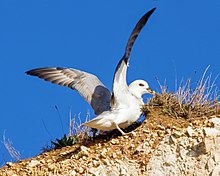Fulmar
| Fulmar | |
|---|---|
 |
|
| Northern fulmar | |
| Scientific classification | |
| Kingdom: | Animalia |
| Phylum: | Chordata |
| Class: | Aves |
| Order: | Procellariiformes |
| Family: | Procellariidae |
| Genus: |
Fulmarus Stephens, 1826 |
| Species | |
|
|
The fulmars are tubenosed seabirds of the family Procellariidae. The family consists of two extant species and two extinct fossils from the Miocene.
Fulmars superficially resemble gulls, but are readily distinguished by their flight on stiff wings, and their tube noses. They breed on cliffs, laying a single egg on a ledge of bare rock. Outside the breeding season, they are pelagic, feeding on fish, squid and shrimp in the open ocean. They are long-lived for birds, living for up to 40 years.
Historically, the northern fulmar lived on the Isle of St Kilda, where it was extensively hunted. The species has expanded its breeding range southwards to the coasts of England and northern France.
As members of Procellaridae and then the order Procellariiformes, they share certain traits. First, they have nasal passages that attach to the upper bill called naricorns. The bills of Procellariiformes are unique in being split into between seven and nine horny plates. Finally, they produce a stomach oil made up of wax esters and triglycerides that is stored in the proventriculus. This can be sprayed out of their mouths as a defence against predators and as an energy rich food source for chicks and for the adults during their long flights. It will mat the plumage of avian predators, which can lead to their death. Fulmars have a salt gland that is situated above the nasal passage and helps desalinate their bodies, due to the high amount of ocean water that they imbibe. It excretes a strong saline solution from their nose.
...
Wikipedia
